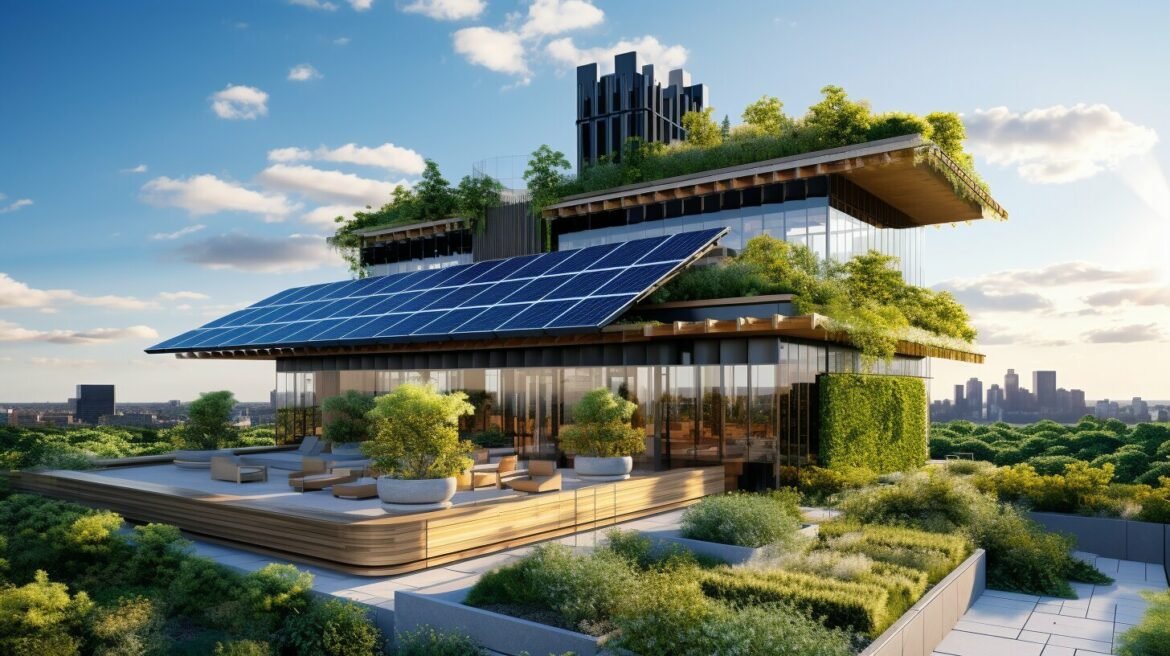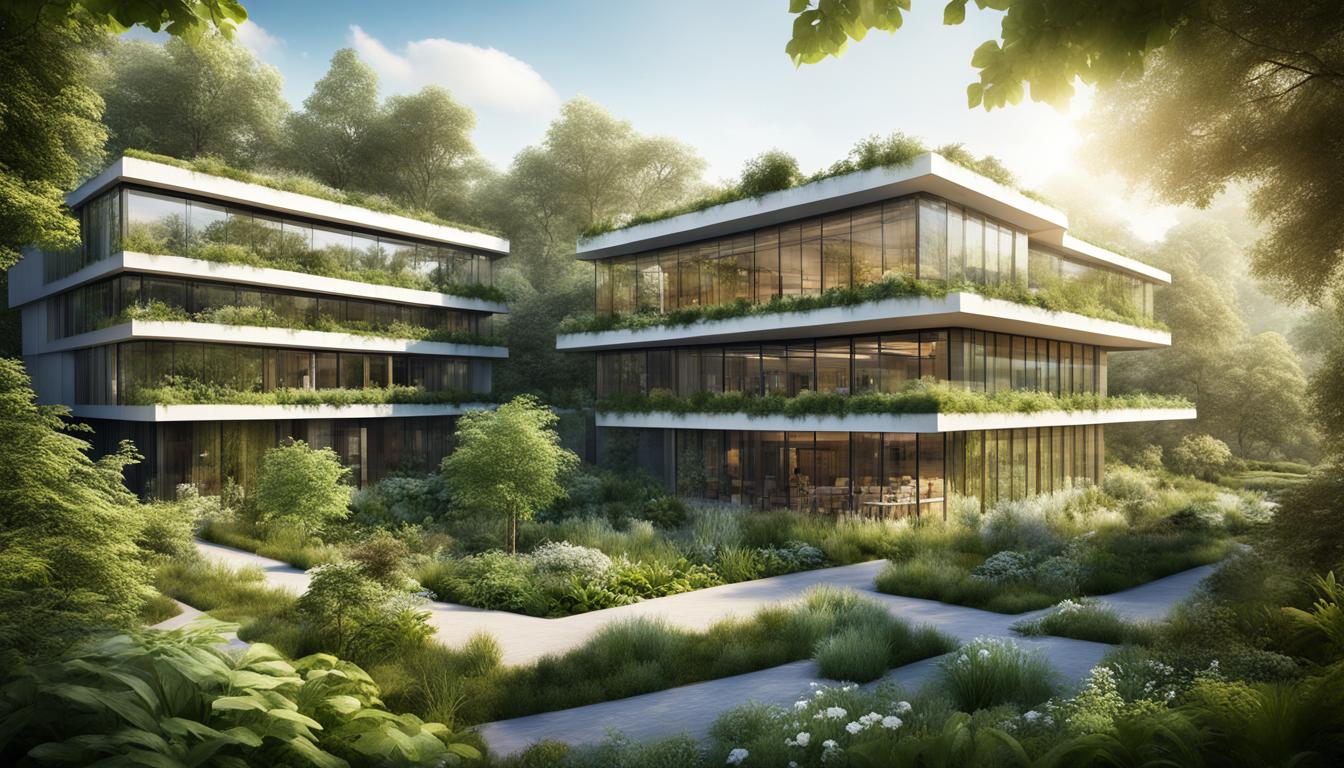How to turn the corner to a nature positive future in the built environment
Welcome to our article on creating a nature positive future in the built environment. As the world continues to face environmental challenges, it’s crucial that we find ways to reduce our impact on the planet. One way to achieve this is through a nature positive approach to architecture and design in the built environment. In this article, we will explore the steps needed to turn the corner towards a nature positive future, providing practical solutions and innovative ideas for sustainable living.
Key Takeaways:
- A nature positive future in the built environment is achievable through sustainable living practices and eco-friendly initiatives.
- We must embrace sustainability in the construction industry and harness renewable energy to promote a greener future.
- Preserving biodiversity, adapting to climate change, and reducing carbon footprints are crucial steps towards a nature positive future.
- Creating sustainable living spaces in urban environments and practicing responsible consumption are important for achieving a nature positive future.
Embracing sustainability in the construction industry
The construction industry is responsible for a significant amount of global carbon emissions and resource depletion. However, there are several ways in which the industry can embrace sustainability and contribute to a nature positive future.
Green Building Certification
A popular practice in the sustainable construction industry is to acquire green building certifications such as LEED or BREEAM. These certifications require projects to meet specific sustainability criteria, including reducing energy and water consumption, using eco-friendly materials, and implementing efficient waste management practices.

Adopting Eco-Friendly Materials
Another way for the construction industry to promote sustainability is to use eco-friendly materials such as recycled steel, bamboo, and straw bale. These materials require fewer resources to produce and have a lower carbon footprint than traditional building materials.
Efficient Waste Management
The construction industry generates a significant amount of waste. However, by implementing efficient waste management practices, such as waste segregation, recycling, and upcycling, the industry can significantly reduce its environmental impact.
By embracing sustainability, the construction industry can play a major role in promoting a nature positive future. From green building certifications to using eco-friendly materials and implementing efficient waste management practices, there are several ways in which the industry can reduce its environmental impact and create a more sustainable future.
Environmental conservation through eco-friendly initiatives.
As we strive towards a nature positive future in the built environment, it is essential that we focus on environmental conservation. There are various eco-friendly initiatives that can contribute to this goal and ensure that we leave a healthier planet for future generations.
One such initiative is the use of green roofs in building design. These roofs are covered in plants and vegetation, providing natural insulation that reduces energy consumption and absorbs rainwater runoff. Moreover, green roofs create habitats for birds and insects, contributing to biodiversity preservation in urban environments.
| Eco-friendly initiative | Benefits |
|---|---|
| Solar panels | Use renewable energy source, reduce carbon footprint, save on energy costs. |
| Water conservation systems | Reduce water usage, minimize pollution and waste of resources, save on water costs. |
| Recycling programs | Reduce waste generation, lower environmental impact, conserve natural resources. |
Solar panels are another eco-friendly solution that can help reduce our reliance on non-renewable energy sources and minimize our carbon footprint. By harnessing the power of the sun, we can generate clean energy that doesn’t produce harmful greenhouse gas emissions. This not only benefits the environment but can also lead to significant savings on energy costs in the long run.
Additionally, water conservation systems can help reduce water usage and minimize pollution and waste of resources. Recycling programs are also an effective way to reduce waste generation and lower our environmental impact while conserving natural resources. By implementing these initiatives, we can contribute to environmental conservation and achieve a nature positive future.

Let’s take action towards a more sustainable future by embracing eco-friendly solutions and promoting environmental conservation.
Harnessing renewable energy for a greener future
Rising concerns over climate change have intensified the focus on renewable energy in recent years, with many businesses and communities exploring new ways to harness the power of nature to promote a greener future. Solar, wind, hydro, and geothermal energy are just a few of the renewable resources that are being increasingly utilised in the built environment, helping to reduce greenhouse gas emissions and mitigate the damage caused by traditional energy sources.
One of the key advantages of renewable energy is its scalability; from small residential solar panels to large-scale wind farms, renewable energy can be adapted to meet the needs of a wide range of communities and industries. Moreover, renewable energy can help reduce energy costs over time, as the technology becomes more widespread and infrastructure is developed to support it.
Green initiatives
A number of green initiatives are already in place around the world to promote renewable energy adoption and encourage sustainable living. For example, the Green Energy Plan is a government-backed initiative in the UK that provides incentives for businesses and homeowners to invest in renewable energy sources such as solar, wind, and biomass. Similarly, the Carbon Trust is a non-profit organisation that works with companies and public sector organisations to reduce carbon footprints and increase energy efficiency through the use of renewable energy.
Other green initiatives include the development of eco-friendly buildings that are designed to maximise natural light and ventilation, as well as the promotion of sustainable transportation options such as electric and hybrid vehicles. Many communities are also exploring the potential of localised energy production, such as community solar power projects, which can help reduce reliance on traditional energy sources and create a more self-sufficient, resilient energy system.

As technology continues to evolve and infrastructure for renewable energy becomes more widespread, the potential for a greener, more sustainable future in the built environment is becoming increasingly realistic. Whether it’s through the use of solar panels, wind turbines, or other renewable resources, the possibilities for harnessing the power of nature are endless. By investing in renewable energy and supporting green initiatives, we can help create a better, more sustainable future for ourselves and generations to come.
Preserving biodiversity in the built environment
In the face of rapid urbanization and construction, preserving biodiversity in the built environment has become more important than ever before. The loss of natural habitats, fragmentation of ecosystems, and introduction of non-native species can have devastating effects on local flora and fauna. However, there are strategies and practices that can help mitigate these impacts and promote a nature positive future.
One such strategy is the implementation of green roofs and walls in buildings. Green roofs not only provide habitat for plants and animals but also reduce urban heat island effects and improve air quality. Similarly, green walls can help regulate temperature and humidity while creating vertical gardens for biodiversity.
Another approach is to incorporate green spaces and natural features into urban design. This can include the creation of parks, wetlands, and wildlife corridors that provide habitat and connect fragmented ecosystems. In addition, preserving existing natural areas such as urban forests and wetlands can help maintain biodiversity in otherwise developed areas.
It is also important to consider the use of native plant species in landscaping and green spaces. Native plants provide food and shelter for local wildlife and are better adapted to the local environment, reducing the need for irrigation and fertilizers.
Overall, preserving biodiversity in the built environment requires a commitment to sustainable and eco-friendly practices. By implementing strategies such as green roofs, incorporating green spaces into urban design, and using native plant species, we can create a more nature positive future for both humans and wildlife.

Adapting to Climate Change through Sustainable Design
As the effects of climate change become increasingly apparent, it’s more important than ever that we take steps to mitigate its impact. In the built environment, sustainable design can play a crucial role in adapting to the changing climate.
One of the key ways in which sustainable design can help is by reducing energy consumption. By implementing energy-efficient building design, we can reduce our reliance on non-renewable energy sources and lower our carbon footprint. This not only helps to mitigate the effects of climate change but also saves money in the long run.
Another aspect of sustainable design in the face of climate change is the use of natural resources. By leveraging renewable resources such as solar and wind power, we can create more sustainable living spaces that are better able to adapt to the changing climate. This not only reduces our impact on the environment but also creates more resilient communities.
It’s worth noting that sustainable design is not just about reducing our impact on the environment; it can also improve our quality of life. For example, green spaces can help to reduce the urban heat island effect, creating more pleasant and liveable environments. By designing buildings and cities with sustainability in mind, we can create spaces that are not only better for the environment but also better for our health and wellbeing.
In conclusion, sustainable design is essential for adapting to the effects of climate change in the built environment. By reducing energy consumption, leveraging renewable resources, and improving quality of life, we can create more sustainable and resilient communities that are better equipped to face the challenges of the future.

Practicing responsible consumption for a nature positive future
As individuals and businesses, we have a critical role to play in creating a nature positive future in the built environment. One way to achieve this goal is by practicing responsible consumption.
Responsible consumption refers to making conscious choices about what we buy and how we use it. By doing so, we can reduce waste, conserve resources, and minimize the impact of our consumption on the environment.
One way to practice responsible consumption is by choosing products that are eco-friendly and sustainably produced. Look for certifications like Fairtrade, Rainforest Alliance, or Forest Stewardship Council (FSC) when shopping for products like coffee, chocolate, or paper. These certifications guarantee that the products have been produced in an environmentally and socially responsible way.
Another way to practice responsible consumption is by reducing our consumption of single-use plastics. Bring reusable bags, water bottles, and coffee cups when you go out, and avoid buying products with excessive packaging. Small changes like these can have a big impact on reducing waste and preserving natural resources.

Finally, we can practice responsible consumption by choosing to support businesses that prioritize sustainability. Look for companies that have committed to reducing their carbon footprint, using renewable energy, and minimizing waste. By supporting these businesses, we can help create a demand for sustainable products and services and push the industry towards a more nature positive future.
By practicing responsible consumption, we can all contribute to a more sustainable, nature positive future in the built environment.
Reducing Carbon Footprint in the Built Environment
Reducing carbon footprint in the built environment is essential to achieving a nature positive future. Energy-efficient building design, sustainable transportation options, and responsible consumption are all crucial elements in reducing carbon emissions. According to the World Green Building Council, buildings and construction account for 39% of global carbon emissions, making it imperative for the construction industry to adopt eco-friendly practices.
One way to reduce carbon footprint in the built environment is through the use of renewable energy sources. The adoption of renewable energy technologies such as solar panels, wind turbines, and geothermal systems can significantly reduce carbon emissions. Additionally, buildings can be designed and constructed to be energy self-sufficient, producing their own energy through renewable sources.
Another way to reduce carbon footprint is through the use of sustainable transportation options. Encouraging the use of public transportation, cycling, and walking can significantly reduce carbon emissions, particularly in urban areas. The construction of bike lanes and pedestrian walkways can encourage sustainable transportation options and reduce reliance on private cars.
| Sustainable Transportation Options | Estimated Carbon Savings (per year) |
|---|---|
| Switching from a car to bike | 1.3 metric tons of CO2 |
| Switching from a car to public transport | 1 metric ton of CO2 |
| Switching from a car to walking | 0.87 metric tons of CO2 |
Finally, practicing responsible consumption is another critical element in reducing carbon footprint in the built environment. Sustainable design, energy-efficient appliances, and water-saving devices can significantly reduce the environmental impact of buildings. Additionally, reducing waste and promoting recycling can help reduce carbon emissions associated with waste disposal.
Reducing carbon footprint in the built environment is an ongoing process that requires the adoption of sustainable practices in all aspects of construction and daily life. By leveraging renewable energy, promoting sustainable transportation options, and practicing responsible consumption, we can significantly reduce carbon emissions and move towards a nature positive future.

Creating sustainable living spaces in urban environments
Urban environments have unique challenges when it comes to creating sustainable living spaces. With limited space and high population density, it can be difficult to balance the need for green spaces with the demands of urban living. However, there are innovative solutions being developed to tackle these challenges and create sustainable living spaces in urban areas.

One such solution is the development of green roofs. These roofs are covered in vegetation, which helps to absorb rainwater, reduce heat absorption, and mitigate the urban heat island effect. They also provide important habitats for urban wildlife and improve air quality.
Another approach is the use of vertical gardens on urban buildings. These gardens not only add visual interest to the cityscape, but they also help to purify the air and reduce the urban heat island effect. They can also be used to grow fresh produce, providing a source of locally grown food for urban residents.
| Benefits of Green Roofs | Benefits of Vertical Gardens |
|---|---|
| Reduce heat absorption | Purify the air |
| Improve air quality | Reduce the urban heat island effect |
| Provide habitats for urban wildlife | Grow fresh produce |
Another way to create sustainable living spaces in urban areas is through the use of green infrastructure. This includes green spaces like parks and gardens, as well as green infrastructure like bioswales and rain gardens. By incorporating these elements into urban design, cities can reduce stormwater runoff, improve air quality, and enhance the overall livability of urban spaces.
Ultimately, creating sustainable living spaces in urban environments requires a multifaceted approach. By incorporating green roofs, vertical gardens, and green infrastructure into urban design, we can create more livable, sustainable cities for the future.
Conclusion
Creating a nature positive future in the built environment is a crucial step towards preserving our planet’s resources and ensuring a sustainable future for generations to come. By embracing sustainability in the construction industry, implementing eco-friendly initiatives, harnessing renewable energy, preserving biodiversity, and reducing our carbon footprint, we can make a positive impact on our environment.
It is up to each and every one of us to take responsibility for our actions and choices. Practicing responsible consumption and creating sustainable living spaces in urban environments are just a couple of the ways we can make a difference.
By working together towards a nature positive future and continuing to innovate in sustainable design and architecture, we can make our cities and communities more sustainable and resilient to the effects of climate change. Let’s take action today to create a brighter and greener tomorrow.
FAQ
Q: What is a nature positive future in the built environment?
A: A nature positive future in the built environment refers to a vision where the construction industry and urban development prioritize the preservation and enhancement of nature. It involves sustainable practices that minimize environmental impact and promote biodiversity, resulting in a harmonious and eco-friendly urban landscape.
Q: Why is embracing sustainability important in the construction industry?
A: Embracing sustainability in the construction industry is crucial to mitigate the negative environmental effects of urban development. By adopting eco-friendly practices, such as using renewable materials, reducing waste, and implementing energy-efficient designs, we can create buildings that have a minimal carbon footprint and contribute to a more sustainable future.
Q: How can eco-friendly initiatives contribute to environmental conservation?
A: Eco-friendly initiatives play a vital role in environmental conservation as they prioritize the sustainable use of resources and minimize negative impacts. By implementing practices like rainwater harvesting, green roofs, and waste management systems, we can protect ecosystems, conserve water, reduce pollution, and create a healthier environment for both humans and wildlife.
Q: What is the role of renewable energy in promoting a greener future?
A: Renewable energy plays a significant role in promoting a greener future by reducing reliance on fossil fuels and decreasing greenhouse gas emissions. Utilizing solar, wind, and hydroelectric power sources for both residential and commercial purposes can help create a sustainable energy system and contribute to the fight against climate change.
Q: How can we preserve biodiversity in the built environment?
A: Preserving biodiversity in the built environment involves incorporating nature-friendly designs and practices. This includes creating green spaces, planting native trees and plants, and implementing wildlife-friendly measures like bird habitats and insect-friendly gardens. By doing so, we can provide habitats for species, promote ecological balance, and enhance the overall quality of urban areas.
Q: Why is sustainable design important in the face of climate change?
A: Sustainable design is crucial in the face of climate change as it allows us to adapt and mitigate its effects. Through energy-efficient buildings, smart urban planning, and resilient infrastructure, we can reduce carbon emissions, improve disaster resilience, and create livable spaces that can withstand the challenges of a changing climate.
Q: How does responsible consumption contribute to a nature positive future?
A: Responsible consumption, both on an individual and business level, plays a vital role in creating a nature positive future. By making conscious choices like buying sustainably sourced products, minimizing waste, and supporting eco-friendly businesses, we can reduce our ecological footprint and contribute to a more sustainable built environment.
Q: What strategies can be used to reduce carbon footprints in the built environment?
A: Strategies for reducing carbon footprints in the built environment include energy-efficient building design, promoting renewable energy usage, adopting green transportation options, and implementing effective waste management systems. These measures can significantly reduce greenhouse gas emissions and contribute to a more sustainable and environmentally friendly urban landscape.
Q: How can we create sustainable living spaces in urban environments?
A: Creating sustainable living spaces in urban environments requires innovative solutions that balance environmental, social, and economic factors. This can involve designing green rooftops, implementing urban agriculture, promoting walkability and public transportation, and encouraging community engagement. By integrating sustainability into urban planning, we can create thriving, livable cities for the future.








